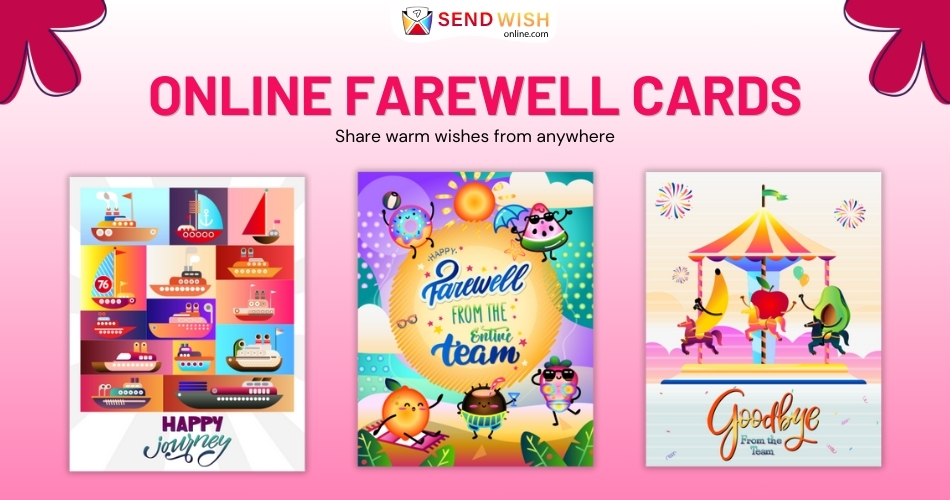Saying goodbye is never easy; farewells bring a mix of joy, nostalgia, and sometimes a touch of sadness as someone embarks on a new path. Whether it’s a colleague moving to a different role, a friend relocating, or a team member retiring, a farewell card is a meaningful gesture. More than just a formality, a well-thought-out card can become a cherished keepsake filled with appreciation, fond memories, and best wishes. Here’s a guide on how to create a memorable farewell card that truly resonates with the recipient.
1. The Importance of a Farewell Card
A farewell card serves as more than a simple goodbye—it’s a celebration of shared experiences, accomplishments, and connections. Farewell card give us a chance to express gratitude, acknowledge contributions, and send well-wishes for what lies ahead. When thoughtfully crafted, a farewell card becomes a lasting reminder of the bonds formed and the difference someone made.
2. Crafting a Personalized Message
The heart of any farewell card lies in its message. Here are some tips to create a personalized, memorable message:
-
Recall Shared Moments: Mention specific memories or shared experiences to make the message more meaningful. Recalling a challenging project or an inside joke shows thoughtfulness and can bring a smile.
- Example: “I’ll never forget those late nights working on the Johnson project—your sense of humor kept us all going. Thank you for being such a fantastic teammate.”
-
Express Appreciation: Acknowledge the unique qualities that made an impact, such as their positive attitude or attention to detail.
- Example: “Your dedication and energy have been such an inspiration to all of us. We’ll miss the positivity you brought to every meeting!”
-
Offer Well-Wishes for the Future: Include a warm wish for their next chapter to show you’re rooting for their success and happiness.
- Example: “Wishing you all the best as you start this exciting new journey. I know you’ll continue to inspire and succeed wherever you go!”
3. Choosing the Right Tone
The tone of the farewell card should reflect your relationship with the recipient:
-
Casual and Lighthearted: For friends or close colleagues, a casual, humorous tone can lighten the mood.
- Example: “Who’s going to keep us sane during those long meetings now? We’re all going to miss your coffee runs and laughter!”
-
Professional: For a manager or colleague in a formal setting, use a respectful and appreciative tone.
- Example: “It has been an honor working under your guidance. Your leadership and insight will truly be missed.”
-
Sentimental: If you have a close bond with the person, a heartfelt message is fitting.
- Example: “You’re more than just a coworker—you’re a friend and a mentor. Thank you for everything you’ve taught me and the kindness you’ve shown.”
4. Incorporating Quotes or Poems
If finding the right words feels challenging, meaningful quotes or short poems can beautifully capture the sentiment. Here are a few ideas:
- “How lucky I am to have something that makes saying goodbye so hard.” — A.A. Milne
- “Every new beginning comes from some other beginning’s end.” — Seneca
5. Adding a Creative Touch
Consider adding personalized elements to make the card truly unique:
-
Handmade Designs: A handmade card adds a personal touch and shows extra effort. You don’t need to be an artist; simple illustrations, stickers, or a photo collage can make the card stand out.
-
Group Messages: For group settings, ask others to contribute. When everyone shares their thoughts, it shows the collective appreciation of the entire team.
-
Memory Collage: Use photos, ticket stubs, or other mementos to create a visual memory collage. This touch makes the card a walk down memory lane.
-
Digital Farewell Card: If the person is in a different location, a digital card allows for personalized messages, GIFs, or video clips from colleagues.
6. Respecting Cultural and Personal Sensitivities
When creating a farewell card, keep in mind the recipient’s cultural and personal preferences. Tailoring the message to align with their values or traditions makes it even more meaningful.
-
Cultural Sensitivity: If the person is from a different cultural background, incorporating elements of their culture (such as a traditional phrase or symbol) can add a thoughtful touch.
-
Honoring Personal Values: Reflect their personal values or career goals, especially if they’re embarking on a meaningful new journey.
7. Choosing Physical or Digital Cards
Both physical and digital cards have their advantages:
-
Physical Cards: A tangible card has a classic, personal feel. It can be hand-delivered or include small mementos. Some people appreciate having something to keep and revisit.
-
Digital Cards: Ideal for remote farewells, digital cards allow for added creativity with animations, GIFs, and video messages. Websites like SendWishOnline.com let multiple people sign the same e-card, making it easy for teams spread across locations to contribute.
8. Conclusion: Leaving a Lasting Impression
A heartfelt farewell card can be a cherished memory, capturing both gratitude and well-wishes. By focusing on shared memories, personal messages, and thoughtful touches, you create more than just a card—you create a meaningful keepsake that celebrates the shared journey. A farewell card done with care speaks volumes and, above all, leaves a lasting impression that’s sure to be remembered.




